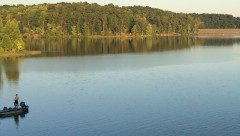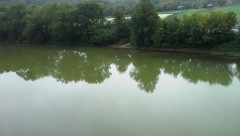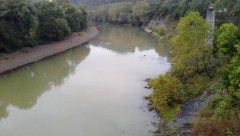ICPRB was interested in exploring methods for developing implementation plans which address TMDLs for multiple constituents. In particular, ICPRB was interested in documenting how methods to control nutrient and sediment can be related to bacteria controls and how management actions required to meet the nutrient and sediment reductions under the Chesapeake Bay TMDL may have benefits for reducing bacteria to meet the goals of local bacteria TMDLs. This interest is an outgrowth of earlier work ICPRB performed for the DC Source Water Assessment, where the Phase 4 Watershed Model was adapted to simulate fecal coliform bacteria so that likely sources of pathogens at DC water intakes could be identified.
After initial research, it was found that a survey and report had already been completed for urban Best Management Practices (BMPs) . The associated database, known as the International Stormwater BMP Database, is available online. A literature survey of bacteria efficiencies for BMPs in the Phase II Watershed Implementation Plans (WIPs) had also been performed as part of an effort to quantify additional benefits from the implementation of the Chesapeake Bay TMDL. This findings report documents the key elements in the urban BMP database and the more general survey quantifying the additional benefits from BMP implementation.
The findings of these two reports are documented below.
International Stormwater Best Management Practices Database
The International Stormwater Best Management Practices Database was developed by Wright Water Engineer and Geosyntec Consultants on behalf of the American Society of Civil Engineers, the U. S. Environmental Protection Agency, the Water Environment Research Foundation, the Federal Highway Administration, and the American Public Works Association. As of 2010, the BMP Database contained 2,500 analysis results for indicator bacteria from 141 studies. Most of the results were for fecal coliform bacteria. Bacteria reduction efficiencies were documented for the following BMPs:
| Grass Strips |
Green Roofs |
| Grass Swales |
Infiltration Trenches |
| Bioretention |
Porous Pavement |
| Dry Detention Basins |
Wet Retention Ponds |
| Sand Filters (or filters with other media) |
Artificial Wetlands |
A parallel effort to develop a database for agricultural BMPs is underway but it does not appear that the effects of agricultural BMPs on indicator bacteria will be addressed by the database.
Additional beneficial outcomes of implementing the Chesapeake Bay TMDL: Quantification and description of ecosystem services not monetized
As part of a study for the EPA to estimate additional benefits derived from Chesapeake Bay TMDL implementation, Wainger et al. quantified the amount of bacteria reduction associated with implementation of the Phase II WIPs. As part of that effort, Wainger et al. performed a literature review of reported BMP efficiencies for reducing pathogens or associated indicator bacteria. The review was conducted using Google Scholar, EBSCO, and Google. Efficiencies were taken from three sources: peer-reviewed journal articles, TMDL documentation from state agencies, and BMP guidance reports from state agencies and research universities. Appendix A of their report summarizes the bacteria reduction efficiencies found for the BMPs used in the state WIPs. The report relied heavily on the International Stormwater BMP Database for efficiencies for urban BMPs. Efficiencies for agricultural BMPs were derived to a large extent on guidance documents or TMDLs from Texas[1], Minnesota[2], and Virginia[3]. Bacteria reduction efficiencies for the following non-urban BMPs were determined through the literature review:
| Barnyard Runoff Control |
Pasture Management |
| Land Retirement |
Loafing Lot Management |
| Pasture Alternative Watering |
Precision Grazing |
| Stream Access Control (Fencing) |
Livestock and Poultry Waste Management Systems |
| Forest Buffers |
Grass Buffers |
Please contact us for more information.
[1]Peterson, J., E. Jordan, K. Wagner, and L. Redmon. 2012b. Lone Star Healthy Streams: Dairy Cattle Manual. Page 80. Department of Soil and Crop Sciences and AgriLife Communications, The Texas A&M System. Retrieved online.
Peterson, J., L. Redmon, and McFarland, Michael. 2011a. Reducing Bacteria with Best Management Practices for Livestock: Prescribed Grazing. Page 2. Texas AgriLife Extension Service. Retrieved online.
Peterson, J., L. Redmon, and McFarland, Michael. 2011b. Reducing Bacteria with Best Management Practices for Livestock: Access Control. Page 2. Texas AgriLife Extension Service. Retrieved online.
[2]MPCA. 2009. Groundhouse River Fecal Coliform and Biota (Sediment) Total Maximum Daily Load Implementation Plan. Page 61. Minnesota Pollution Control Agency. Retrieved online.
[3]VDEQ. 2003. Total Maximum Daily Load Development for Linville Creek: Bacteria and General Standard (Benthic) Impairments. Page 160. Virginia Department of Environmental Quality.
Wainger, L. , J. Richkus, and M. Barber. 2015. Additional beneficial outcomes of implementing the Chesapeake Bay TMDL: Quantification and description of ecosystem services not monetized. Oneida Total Integrated Enterprises, LLC: Oak Ridge, TN. Retrieved online.





